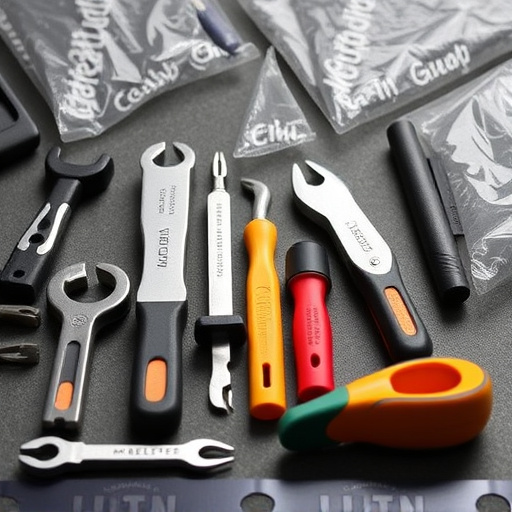Unveiling the Science of Perfect Color Matching in Collision Repair

Mastering color theory and advanced tools are vital for achieving color matching excellence in vehic…….
In a world where visual aesthetics play a pivotal role, color matching excellence stands as a cornerstone of various industries, from manufacturing and design to fashion and art. This concept, which involves achieving precise and consistent color reproduction, has evolved significantly over time, driven by technological advancements and a growing demand for perfection. In this comprehensive article, we will embark on a journey through the intricacies of color matching excellence, exploring its historical foundations, global impact, economic implications, technological innovations, regulatory framework, challenges, and the future it holds. By delving into these aspects, we aim to provide an insightful understanding of why this topic is not just about aesthetics but also about efficiency, innovation, and international collaboration.
Definition: Color matching excellence refers to the art and science of achieving precise color replication across different mediums and platforms. It involves a complex interplay of physics, optics, and human perception, ensuring that colors appear identical or, at the very least, harmoniously similar under various lighting conditions and viewing angles.
At its core, this discipline encompasses several critical components:
Color Space and Models: Color is represented in digital and physical formats using color spaces like RGB (Red, Green, Blue), CMYK (Cyan, Magenta, Yellow, Black), and HSV (Hue, Saturation, Value). Each space defines a set of parameters to describe colors, enabling consistent communication and reproduction.
Color Measurement: Accurate measurement is key. Devices such as color meters and spectrophotometers are used to quantify light and determine a color’s characteristics, ensuring precise comparison and replication.
Color Reproduction Techniques: These include methods like additive (e.g., RGB displays) and subtractive (e.g., printing inks) color mixing, each requiring specific considerations for optimal results.
Color Management: This involves the use of software and hardware systems to ensure consistent color interpretation and reproduction across different devices and workflows, bridging the gap between physical and digital media.
Historical Context: The quest for perfect color replication dates back centuries, with early artists using carefully mixed pigments to achieve specific hues. However, it was the advent of photography in the 19th century that sparked a more scientific approach. As technology advanced, so did our understanding of color, leading to the development of color spaces and measurement standards. The printing industry played a significant role in establishing color management practices to ensure consistent output across various presses and media.
Significance: Color matching excellence is not merely about making things look good; it has far-reaching implications:
Color matching excellence has become a global phenomenon, shaping industries worldwide and fostering international collaboration in standards development. Here’s an overview:
Regional Disparities: While many regions have embraced color management practices, adoption rates vary. For instance, countries with robust manufacturing and design sectors, such as Japan, Germany, and the United States, tend to lead in color matching excellence, while others are gradually catching up.
International Standards: Organizations like the International Organization for Standardization (ISO) play a crucial role by establishing guidelines and standards for color measurement and management. The ISO 105 series, for example, covers color measurement and assessment of textile colors, ensuring consistency across international markets.
Technological Leaps in Different Regions: Asia, particularly South Korea and China, has witnessed significant advancements in color management technologies, driven by their thriving electronics and display industries. European countries are known for their expertise in printing and ink technologies, contributing to high-quality color reproduction in the publishing sector.
Regional Specializations: Some regions have developed unique approaches to cater to local needs. For instance, the fashion industry in Italy is renowned for its meticulous attention to color, while the Middle East has made significant strides in color management for the construction and automotive sectors.
The economic implications of color matching excellence are profound, impacting various industries and market dynamics.
Technological innovations have been instrumental in advancing color matching excellence, opening up new possibilities and pushing the boundaries of what’s achievable.
Digital Color Management: The digital age has brought about sophisticated color management systems that enable accurate color interpretation and reproduction across devices, networks, and platforms. These systems use profiles, tags, and metadata to ensure colors remain consistent throughout the entire production chain.
Spectral Measurement Technology: Advancements in spectrophotometers have improved measurement accuracy and speed. Modern devices can capture a wide range of wavelengths, providing detailed color data for precise analysis and reproduction.
Printed Electronics and Inkjet Printing: These technologies enable the creation of electronic circuits and high-resolution printing on various surfaces, including textiles and plastics. Precise control over ink deposition ensures consistent color and functionality in these applications.
Virtual Reality (VR) and Augmented Reality (AR): VR and AR systems demand accurate color representation to create immersive experiences. Technologies like HDRI (High Dynamic Range Imaging) capture a wide range of colors, ensuring realistic visuals.
Machine Learning Applications: AI algorithms are being used to analyze and predict color outcomes, streamlining workflows and improving efficiency in various industries. Machine learning models can adapt to new data, enhancing color matching over time.
The significance of color matching excellence has led to the development of policies and regulations aimed at ensuring consistent and ethical color practices.
International Trade Agreements: Bilateral and multilateral trade agreements often include provisions for product standardization, covering aspects of color consistency to protect consumers and facilitate fair trade.
Industry-Specific Standards: Various industries have developed their standards and guidelines. For instance, the printing industry’s ISO 12647 series provides guidelines for color management in print production, ensuring high-quality output.
Data Privacy and Security: As color data becomes more digital and sensitive, policies related to data protection and privacy gain importance. Ensuring secure handling of color profiles and metadata is crucial for maintaining color consistency and client confidentiality.
Environmental Considerations: Some regulations focus on the environmental impact of colorants and inks, encouraging the use of eco-friendly materials and practices in manufacturing and printing industries.
Despite its many advantages, color matching excellence faces challenges that require innovative solutions and collaborative efforts.
Perceptual Differences: Human perception of color varies due to factors like lighting conditions, background colors, and individual differences in vision. Achieving universal agreement on color reproduction can be difficult.
Technological Limitations: Current measurement devices have limitations in terms of speed, accuracy, and dynamic range. Developing more advanced tools remains a priority.
Standardization Gaps: While international standards exist, there are still gaps, especially in emerging technologies like VR/AR and certain specialized industries. Standardization efforts need to be ongoing and adaptable.
Cost Implementation: Implementing color management practices across global supply chains can be costly, particularly for smaller businesses, creating a barrier to entry.
Enhanced Measurement Technologies: Continued research and development are needed to create more precise measurement devices, addressing perceptual differences through advanced algorithms and lighting controls.
Collaborative Standardization: Industries should actively participate in developing and refining standards, ensuring they remain relevant and practical for diverse applications.
Digital Transformation: Embracing digital color management systems can streamline processes and reduce costs, making color excellence more accessible.
Education and Training: Providing resources and training programs can help businesses understand the benefits of color matching excellence and offer guidance on implementing best practices.
France, renowned for its artistic heritage, has perfectly aligned color matching excellence with historical preservation. In a collaborative effort, French art restorers and scientists developed advanced techniques to reproduce the original colors of famous masterpieces, ensuring their authenticity for future generations. By combining traditional knowledge with modern measurement technologies, they have successfully restored iconic works, preserving not just the art but also the artistic intent and visual harmony.
Toyota, a global automotive leader, has consistently emphasized color consistency across its vehicle models. The company’s color management system ensures that colors remain true from the moment of manufacturing to delivery. By employing advanced measurement devices and digital workflows, Toyota maintains strict quality control, resulting in high customer satisfaction and brand loyalty. This attention to detail has contributed to the company’s reputation for excellence.
Nike, the athletic apparel giant, has utilized color matching excellence to create visually stunning and highly functional clothing lines. Through precise color mixing and advanced printing techniques, Nike ensures that colors on their products remain vibrant and consistent, even after extensive use and exposure to various elements. This dedication to color quality has become a hallmark of their brand, captivating athletes and fashion enthusiasts alike.
The future of color matching excellence is filled with promising possibilities, driven by technological advancements and evolving market demands.
AI-Powered Color Prediction: Artificial intelligence will play a pivotal role in predicting color outcomes, streamlining design and manufacturing processes, and reducing time-to-market.
Sustainable Colorants: With growing environmental concerns, there will be an increased focus on developing eco-friendly colorants and inks, ensuring color excellence while minimizing the industry’s ecological footprint.
Immersive Technologies: As VR and AR continue to evolve, so will the need for precise color reproduction in these applications, opening up opportunities for innovative solutions and partnerships.
Global Collaboration: Standardization bodies should foster international cooperation to address emerging trends and ensure global compatibility, especially in rapidly growing industries like electronics and digital media.
Continuous Learning: Industries must embrace a culture of continuous learning and adaptation, staying abreast of technological advancements and market shifts to maintain a competitive edge.
Data Security: As color data becomes more valuable, securing it through robust encryption and secure storage methods will be essential to protect intellectual property and client privacy.
Color matching excellence is not merely a technical pursuit; it is a catalyst for innovation, efficiency, and global collaboration. As we’ve explored, its impact permeates various sectors, from art and design to manufacturing and technology. By understanding the core concepts, historical context, and future trends, professionals across industries can harness the power of color to create visually stunning, consistent, and high-quality products and experiences.
The journey towards excellence in color management is an ongoing one, requiring continuous learning, adaptation, and collaboration. As technology advances and our understanding of color deepens, we will continue to witness groundbreaking applications and innovative solutions. Ultimately, color matching excellence is a testament to human creativity and our relentless pursuit of perfection in the visual realm.
Q: What is the main goal of color matching excellence?
A: The primary goal is to achieve precise and consistent color reproduction across different mediums and platforms, ensuring colors appear identical or harmoniously similar under various conditions.
Q: How does color matching excellence benefit businesses?
A: It enhances product quality, reduces costs by minimizing rework, improves customer satisfaction, enables efficient workflows, and provides a competitive edge in the market.
Q: Are there any common misconceptions about color matching excellence?
A: One common misconception is that it solely concerns artists and designers. However, it is equally crucial for manufacturing, printing, and technology industries, among others. Another misconception is that perfect color matching is always achievable; human perception and environmental factors introduce inherent variations.
Q: What role does international cooperation play in color matching excellence?
A: International collaboration is vital for establishing global standards, ensuring compatibility across borders, and facilitating international trade by reducing disputes related to product quality and appearance.
Q: How can businesses get started with implementing color management practices?
A: Businesses can begin by conducting a color audit to assess current processes, investing in training and education, adopting digital color management systems, and establishing clear color specifications and workflows. Regular monitoring and calibration of devices are also essential.

Mastering color theory and advanced tools are vital for achieving color matching excellence in vehic…….

Digital tools revolutionize color matching in vehicle repair, especially for brands like Mercedes Be…….

Automotive body technicians play a crucial role in achieving color matching excellence, vital for ve…….

Achieving color matching excellence is crucial at auto shows and post-show repairs for luxury vehicl…….

Light, temperature, humidity, and air quality significantly impact color perception and achieving co…….

Digital tools revolutionize color matching excellence in automotive repairs, enhancing aesthetics an…….

Color psychology significantly influences buyer perceptions and resale value across real estate, car…….

The text emphasizes the critical role of color matching excellence in programming as a foundational…….

Natural light, temperature, and humidity significantly impact color matching excellence in industrie…….